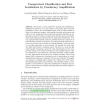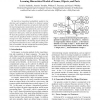284 search results - page 3 / 57 » Learning the parts of objects by auto-association |
JMLR
2006
13 years 8 months ago
2006
Many perceptual models and theories hinge on treating objects as a collection of constituent parts. When applying these approaches to data, a fundamental problem arises: how can w...
ICCV
2011
IEEE
12 years 8 months ago
2011
IEEE
In this work, we propose to use attributes and parts for recognizing human actions in still images. We define action attributes as the verbs that describe the properties of human...
ECCV
2008
Springer
13 years 10 months ago
2008
Springer
We present a novel method for unsupervised classification, including the discovery of a new category and precise object and part localization. Given a set of unlabelled images, som...
ICCV
2005
IEEE
14 years 2 months ago
2005
IEEE
We describe a hierarchical probabilistic model for the detection and recognition of objects in cluttered, natural scenes. The model is based on a set of parts which describe the e...
PAMI
2011
12 years 11 months ago
2011
—We present a discriminative part-based approach for human action recognition from video sequences using motion features. Our model is based on the recently proposed hidden condi...


